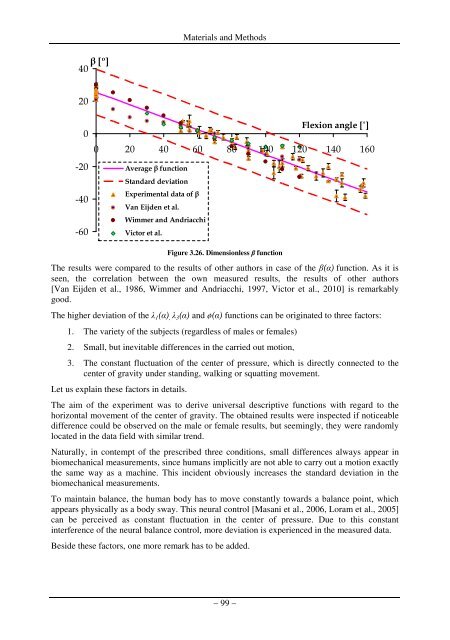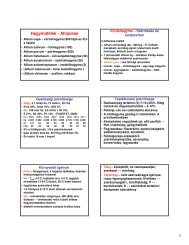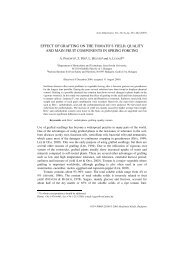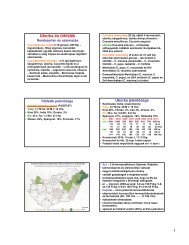PhD Fekete - SZIE version - 2.2 - Szent István Egyetem
PhD Fekete - SZIE version - 2.2 - Szent István Egyetem
PhD Fekete - SZIE version - 2.2 - Szent István Egyetem
Create successful ePaper yourself
Turn your PDF publications into a flip-book with our unique Google optimized e-Paper software.
Materials and Methods<br />
β [º]<br />
40<br />
20<br />
0<br />
-20<br />
-40<br />
-60<br />
Flexion angle [˚]<br />
0 20 40 60 80 100 120 140 160<br />
Average β function<br />
Standard deviation<br />
Experimental data of β<br />
Van Eijden et al.<br />
Wimmer and Andriacchi<br />
Victor et al.<br />
Figure 3.26. Dimensionless β function<br />
The results were compared to the results of other authors in case of the β(α) function. As it is<br />
seen, the correlation between the own measured results, the results of other authors<br />
[Van Eijden et al., 1986, Wimmer and Andriacchi, 1997, Victor et al., 2010] is remarkably<br />
good.<br />
The higher deviation of the λ 1 (α) , λ 3 (α) and ø(α) functions can be originated to three factors:<br />
1. The variety of the subjects (regardless of males or females)<br />
2. Small, but inevitable differences in the carried out motion,<br />
3. The constant fluctuation of the center of pressure, which is directly connected to the<br />
center of gravity under standing, walking or squatting movement.<br />
Let us explain these factors in details.<br />
The aim of the experiment was to derive universal descriptive functions with regard to the<br />
horizontal movement of the center of gravity. The obtained results were inspected if noticeable<br />
difference could be observed on the male or female results, but seemingly, they were randomly<br />
located in the data field with similar trend.<br />
Naturally, in contempt of the prescribed three conditions, small differences always appear in<br />
biomechanical measurements, since humans implicitly are not able to carry out a motion exactly<br />
the same way as a machine. This incident obviously increases the standard deviation in the<br />
biomechanical measurements.<br />
To maintain balance, the human body has to move constantly towards a balance point, which<br />
appears physically as a body sway. This neural control [Masani et al., 2006, Loram et al., 2005]<br />
can be perceived as constant fluctuation in the center of pressure. Due to this constant<br />
interference of the neural balance control, more deviation is experienced in the measured data.<br />
Beside these factors, one more remark has to be added.<br />
– 99 –
















